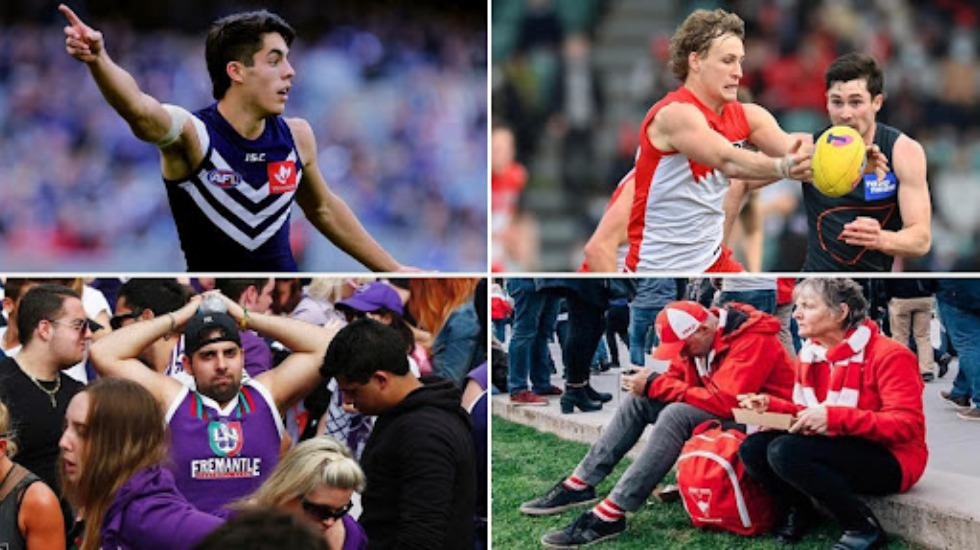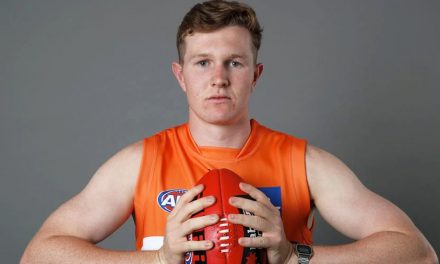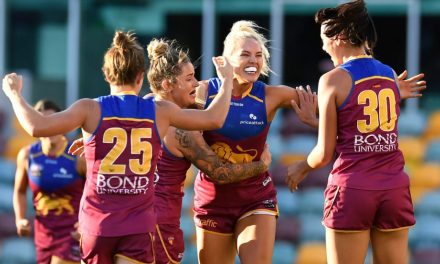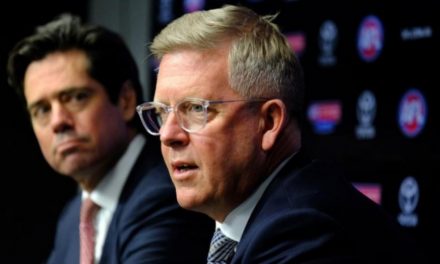Swings and roundabouts: Adam Cerra (top left) has moved, and Jordan Dawson seems set to do likewise, while helpless fans lament. Photos (clockwise from top left): Fox Sports, Fox Sports, Vice, ABC.
Hang onto your hats, footy fans: trade week is here! That time of the year when retired players, football journos and former list managers get to extend their seasons by a week or so (10 days, to be exact) by projecting who’s going where, their true value in draft picks or players sent the other way (good luck with that) and who’s getting ‘bent over’ due to a weak bargaining position (yes, that uncouth term is a thing at this time of year).
“Club X could do with star inside mid from Club Y and, with the help of Club Z, have the draft capital to make it happen. Quick, let’s draw up a mega-trade that’s based on little more than our furtive imaginations!”
The AFL is the world’s only professional football organisation – of any code – presiding over the lopsided scenario where most of its talent is isolated in Australia’s ‘footy’ regions. As of 2019, 85 per cent of its listed players come from Victoria, WA and SA (comprising just 43 per cent of Australia’s population) while Victoria alone accounted for 56.2 per cent of listed AFL players that year.
The league holds another dubious distinction: it’s the only football body that distils all the stress, elation and sense of loss associated with player movement into this one, highly fraught 10-day period. Go hard at the negotiating table and reap the rewards; go too hard and your player might wind up in the pre-season draft.
This combination is especially stressful for staff and supporters of non-Victorian clubs. Every year during trade week, it seems, one or more players get an attack of homesickness, keen to return to the loving embrace of home, family and a club they may well have grown up barracking for.
Sheer weight of numbers (see stats above) means the urge to ‘go home’ is often an urge to return to Victoria. This year, Fremantle fans were the first to cop that sinking feeling you get when a budding star, nurtured for years in your development system, decides to up and go just as he hits his stride.
I refer, of course, to Adam Cerra, a blue-chip inside midfielder who “does things with the football that most AFL players can’t”. Cerra landed at Carlton last Thursday, in exchange for this year’s pick six and a future third-round selection.
His ‘go home’ announcement was accompanied by a digital wailing and gnashing of teeth from Freo fans, and an unsolicited opinion from yours truly that, just maybe, “you should have gone local” at the draft:
I think AFL clubs who invest in young players as first round draft pics who then turn their backs on their team mates to go home should be compensated. Adam Cerra is a prime example. Hugely disappointing.
— Freocookster ⚓ Easy A.Z (@freocookster) August 24, 2021
Hard fact to ponder now https://t.co/MJcRXlp7h4
— adrian barich (@adrianbarich) August 25, 2021
Of course, “going local” isn’t a cure-all: it deprives non-Victorian clubs of a full suite of options when it’s their turn to pick, and in any case, why draft a key forward (Naughton) if you think you need an inside mid (Cerra)? That, in essence, is the quandary faced by ‘interstate’ clubs on draft day: select locals and compromise on talent, or draft the “best player available” and risk their ‘going home’ in a few years.
Clubs from NSW and Queensland – states accounting for around 10 per cent of listed AFL players – are especially vulnerable to the ‘go home’ factor, and are ‘bent over’ most frequently during trade week. So it was this year, when South Australian Jordan Dawson declared his intention to leave Sydney and head home to the Crows.
How much is Dawson worth? After pondering precedents ranging from Jake Lever (two first-round picks at age 21) to Ed Langdon (effectively just a second-round selection in a complex trade, at age 23) Peter Ryan of The Age opined that 24-year-old Dawson “in reality would command a pick between 10 and 15 in this year’s draft, as he is a potential All-Australian.”
What did the Crows offer Sydney? After yanking their early offer of pick 17 (via the Western Bulldogs), Adelaide at the time of writing appears to be offering the Swans a 2022 first-rounder they acquired from Melbourne on Wednesday.
Melbourne, in case you’ve been asleep over the past fortnight, is the reigning premier. Here’s what our good friends at PalmerBet think of the Demons’ chances of repeating next year:

That’s right, the Dees are warm favourites to go back-to-back and deliver Sydney pick 18 (more likely pick 20 after bids for father-son or academy players are matched) if Adelaide’s apparent offer is accepted. If The Age’s estimate of Dawson’s worth is on the money, their average equates to around 1250 points under the current AFL bidding system; Adelaide’s apparent offer is most likely to be the equivalent of 912 points.
PLEASE HELP US CONTINUE TO THRIVE BY BECOMING AN OFFICIAL FOOTYOLOGY PATRON. JUST CLICK THIS LINK.
Adelaide can insult Sydney with offers like this because if the Swans don’t take it, there’s a good chance Dawson will nominate for the pre-season draft (where Adelaide has pick four) and Sydney will get nothing. Such a turn of events would be a bit of a risk for the Crows, too, since cashed-up North Melbourne has pick one in that draft.
Inflaming tensions further on Friday was Adelaide’s rejected offer of three first-round picks – including the 2022 pick from Melbourne apparently offered to Sydney – to North Melbourne in exchange for the overall pick No.1 in this year’s draft. Sydney may conclude Adelaide has been negotiating for Dawson in bad faith, and could even walk away from the table.
Should negotiations continue, there’s little doubt the Swans will be ‘bent over’ by Adelaide before Wednesday’s trade deadline, unless Sydney’s Kinnear Beatson or John Longmire can pull a rabbit out of the hat. Either that or they lose Dawson for nothing in the pre-season draft.
Those who read my stuff over the last month know I have a vested interest in the Dawson situation: I barrack for Sydney, and I’m not happy. Here’s a small selection of Twitter comment from other Swans fans aggrieved by the injustice of it all:
#Swans MUST play hardball with #JordanDawson trade, I would rather him stand out of football than to let him go cheaply. #Swans
— Grant (@crazyjoedevola) October 7, 2021
Interesting move for a club allegedly dealing in good faith with Sydney. Hello @NMFCOfficial I’m sure Dawson will enjoy working with Blakey! #bloods https://t.co/GOCAEoGNRZ
— Damien E (@dexswans) October 8, 2021
That’s right, Sydney fans are so pissed off with Adelaide right now that some are entertaining the possibility he gets to North Melbourne and we get nothing. A tad self-defeating, but such are our stress levels.
The purpose of this article isn’t to mount a broad argument that the AFL draft/trading system is fundamentally flawed, compromised and unfair to NSW and Queensland clubs (much of this should be self-evident) or to ignore the swings, roundabouts and northern academies that, perhaps, help redress the latter. I leave that debate to others.
My point is that it’s all so stressful! Whoever dreamt up the combination of trade week and the annual ‘go home’ pantomime that invariably traumatises fans of non-Victorian clubs is the proud owner of a sadistic streak Vlad the Impaler would admire.
Consider the lot of those fans of non-Victorian clubs – already dismayed at the loss of a young star nurtured by their club over several seasons – who are glued to Twitter or Trade Radio for snippets of negotiations which, they know, will inevitably result in their club being ‘bent over’ in one wanton way or another. Their sheer sense of helplessness is further aggravated when (and this happens a lot) said snippets turn out to be either a beat-up by some journo looking for a headline or misinformation to aid the cause of one club or another.
The pain of it all! Wednesday’s deadline can’t come soon enough!

Of course, it doesn’t have to be this way. The trauma of trade week could easily be replaced by a system of the kind employed by the NFL, where drafted players can become restricted free agents after just three years.
Under that system, an uncontracted player can be offered deals by other clubs, and the contract he signs can be matched by the team that drafted him. If the deal is matched, he stays; if not, his original club is compensated by way of draft picks calculated via a set formula.
In fact, the AFL already has a form of restricted free agency in place … but it kicks in after eight years, not three. Over the five intervening seasons, players, player managers, clubs and fans must at one point or another go through the stress of negotiating for a new contract, deciding whether or not to seek a trade and then – if it’s the latter – endure the entire game of brinkmanship, with all its perils and pitfalls, as described in agonising detail above.
I repeat: the AFL is the only professional football organisation – of any code – that puts everyone through this tortuous 10 days. My question is: why?
What’s that? There’s an entire ecosystem of player managers, club officials, bureaucrats, radio stations, websites, Twitter accounts, journos and commentators that make bank out of trade week?
Say it ain’t so!
Then, of course, there’s the sheer theatre of it all. The punters would miss all the thrill and suspense, wouldn’t they?
Speaking as the fan of a non-Victorian club, I can emphatically answer that in the negative. My (it seems) about-to-be-bent-over club would almost certainly agree.
Fans are prepared to go through the stress of a close game – even if they get beaten – but this trade week thing is what the United Nations calls ‘cruel and unusual’.
At the very least, my fingernails could do with the respite.












As an Adelaide fan I want to to preface this comment before I make a snide but good natured dig. I hate trade week. The number of players I’ve seen leave my club, only to watch as they play in premierships, get All Australian honours and win a Brownlow. It’s the worst week in the AFL calendar.
But…. On Dawson. If we want comparative trades I would like to nominate Kurt Tippett
Yeah, about Tippett: the player and his then-club’s salary cap shenanigans were behind that ‘unfair’ outcome. The ‘unfairness’ was part of the penalty. Ask Steven Trigg if you don’t believe me.
That said, swings and roundabouts on Dawson. The mighty Bloods will store it away in the memory bank and get you next time. 😉
There is a clear problem with a system whereby a player like Dawson goes elsewhere for what almost everyone would say is “unders”. The player nominating a single club and the threat of the PSD creates a very skewed bargaining situation. The Swans would be better off if he was a restricted free agent as at least they could potentially match the Adelaide bid. I am not sure the system is working as the AFL envisaged it would.
Brendan
All clubs trade in and trade out players over time, or gain/lose players as free agents – would hazard a guess that Sydney fans were happy getting Franklin as a free agent, and not that worried about what the Hawks got as compensation. Sydney also took a tough stance with Papley and held him to his contract… Adelaide is also entitled to use the strong position they have in the Dawson trade. I’m sure it won’t be long till the shoe is on the other foot.
I don’t think the complaint is really at Adelaide, but rather the system.
A lot of the issue can be easily fixed however. Make out of contract players not eligible for the PSD unless they have passed through the national draft first. i.e. PSD is for players formally delisted, or not taken in the national draft/rookie drafts only. If a player is out of contract, and wants to leave the club that he is at, then the club either has to come up with a reasonable deal to satisfy the selling club, or trade itself into a position in the national draft where it can take the player – but potentially at the cost of access to young talent of genuine draft age and much more open to other clubs being able to match that value more easily (because of the ability to trade picks). Doesn’t quite completely remove the gamesmanship, but goes a long way towards doing so – and even if the club losing the player doesn’t get the value back in draft picks, at worst the club buying them has to pay something approaching their actual value in the draft.
If you do that, then it suddenly becomes a whole lot harder for a club that is fortunate enough to hold a high pick in the PSD to use it as a way to basically get players for nothing.
At least free agents allow some compensation to be guaranteeed to the club the player is leaving from – even if it can be unders. Hawthorn were premiers remember in the year Buddy left, hence his looks ‘shallow’ in value. And Papley was under contract, so they were perfectly entitled to say no if they wanted to.
The fruit tingles are going to get a reputation if they take Dawson down that route this year, after doing similar last year with Hately from GWS however.